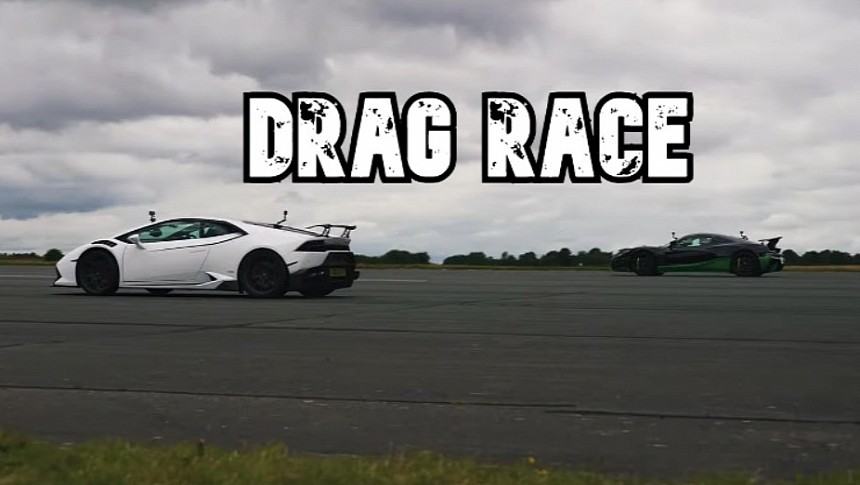The Huracan usually comes with 600-ish ponies from the factory. This particular example of the breed, however, pushes closer to 1,800 because it's a twin-turbo brute tuned by the folks at JM Imports.
According to big kahuna Jurgen Vallons, the JM1800R is rocking 1,800 ps and 1,500 Nm of torque, figures that convert to 1,775 horsepower and 1,106 pound-feet. In addition to the fully built 5.2-liter V10 hiding under the rear deck, the supercar also flaunts a fully built dual-clutch transmission and beefier axle shafts. After all, that kind of torque would easily break the standard Dana Graziano DL800 transmission and all four axle shafts.
Tipping the scales at just around 1,650 kilograms (3,638 pounds), the JM Imports-modified Huracan is ridiculously quick in the quarter mile. Jurgen clocked a best of 8.7 seconds on a runway rather than a super-sticky drag strip. It wasn't enough to keep the Rimac Nevera driven by Mat Watson at bay, though. The four-motor electric hypercar needed 8.5 seconds, which – as you're well aware – is also quicker than the Dodge Challenger SRT Demon 170's official 8.91-second ET.
The Lambo didn't stand a chance from a rolling start to the half mile either. Be that as it may, the Italian midship did brake harder from 100 miles per hour (160 kilometers per hour), stopping in a shorter distance than the Croatian unicorn. Limited to 150 customer vehicles, the Rimac Nevera is quite a bit heavier than the Lambo.
Estimated at circa 2,300 kilograms (5,070 pounds), the Rimac offers 1,914 metric ponies (1,888 hp) and 2,360 Nm (1,741 lb-ft) on full song. Far more expensive than the Huracan, the Nevera is the fastest series-production electric vehicle at the Nurburgring Nordschleife (7:05.298) and at the Goodwood Hillclimb (49.32). The Nevera carries a starting price of around $2.4 million.
Not long now, the Huracan's replacement will also receive a degree of electrification. The heir apparent is due to arrive in the latter half of 2024 for the 2025 model year with plug-in hybrid oomph, a development that shouldn't come as a surprise to supercar enthusiasts. After all, the Revuelto is a plug-in hybrid as well, packing a naturally-aspirated V12 and three e-motors.
The yet-unnamed successor of the Huracan will – sadly – lose two cylinders in favor of two turbochargers. Captured on video making twin-turbo V8 noises, the Baby Lambo has been confirmed to feature a new platform unrelated to that of the Huracan and Audi R8. Based on Revuelto-styled prototypes and the Revuelto's carbon-fiber monocoque, it's likely that the plug-in hybrid V8-powered sibling features a derivative of this very platform rather than a clean-sheet design.
Hearsay suggests a redline of 10,000 revolutions per minute for the V8 and turbos designed to kick in at 7,000 revolutions per minute. 10k for a turbocharged engine designed for a road car is a lot, yet doable. Turbos engaging so high in the engine speed range, on the other hand, defeats the purpose of a force-fed powerplant.
Tipping the scales at just around 1,650 kilograms (3,638 pounds), the JM Imports-modified Huracan is ridiculously quick in the quarter mile. Jurgen clocked a best of 8.7 seconds on a runway rather than a super-sticky drag strip. It wasn't enough to keep the Rimac Nevera driven by Mat Watson at bay, though. The four-motor electric hypercar needed 8.5 seconds, which – as you're well aware – is also quicker than the Dodge Challenger SRT Demon 170's official 8.91-second ET.
The Lambo didn't stand a chance from a rolling start to the half mile either. Be that as it may, the Italian midship did brake harder from 100 miles per hour (160 kilometers per hour), stopping in a shorter distance than the Croatian unicorn. Limited to 150 customer vehicles, the Rimac Nevera is quite a bit heavier than the Lambo.
Estimated at circa 2,300 kilograms (5,070 pounds), the Rimac offers 1,914 metric ponies (1,888 hp) and 2,360 Nm (1,741 lb-ft) on full song. Far more expensive than the Huracan, the Nevera is the fastest series-production electric vehicle at the Nurburgring Nordschleife (7:05.298) and at the Goodwood Hillclimb (49.32). The Nevera carries a starting price of around $2.4 million.
Not long now, the Huracan's replacement will also receive a degree of electrification. The heir apparent is due to arrive in the latter half of 2024 for the 2025 model year with plug-in hybrid oomph, a development that shouldn't come as a surprise to supercar enthusiasts. After all, the Revuelto is a plug-in hybrid as well, packing a naturally-aspirated V12 and three e-motors.
The yet-unnamed successor of the Huracan will – sadly – lose two cylinders in favor of two turbochargers. Captured on video making twin-turbo V8 noises, the Baby Lambo has been confirmed to feature a new platform unrelated to that of the Huracan and Audi R8. Based on Revuelto-styled prototypes and the Revuelto's carbon-fiber monocoque, it's likely that the plug-in hybrid V8-powered sibling features a derivative of this very platform rather than a clean-sheet design.
Hearsay suggests a redline of 10,000 revolutions per minute for the V8 and turbos designed to kick in at 7,000 revolutions per minute. 10k for a turbocharged engine designed for a road car is a lot, yet doable. Turbos engaging so high in the engine speed range, on the other hand, defeats the purpose of a force-fed powerplant.



























